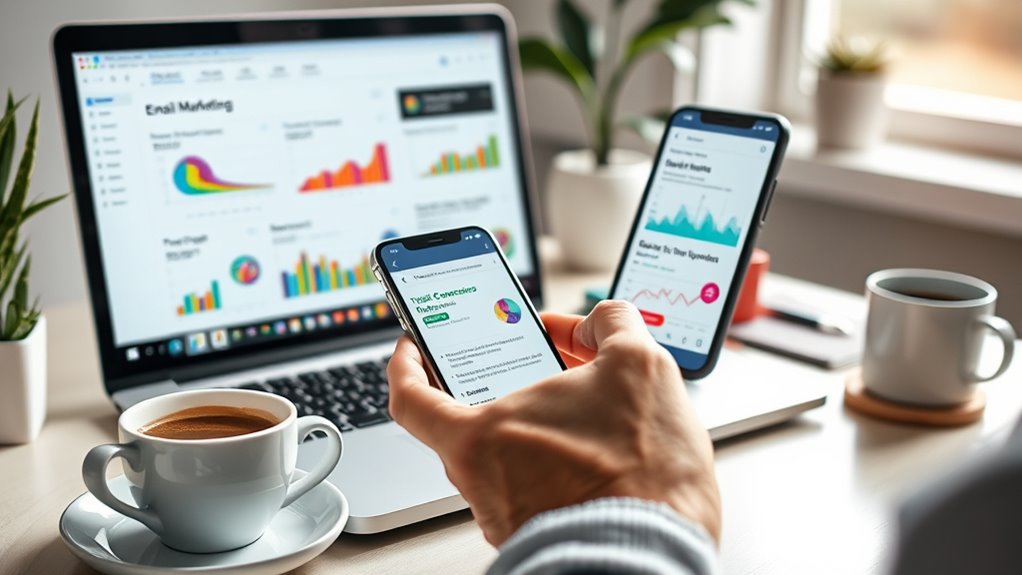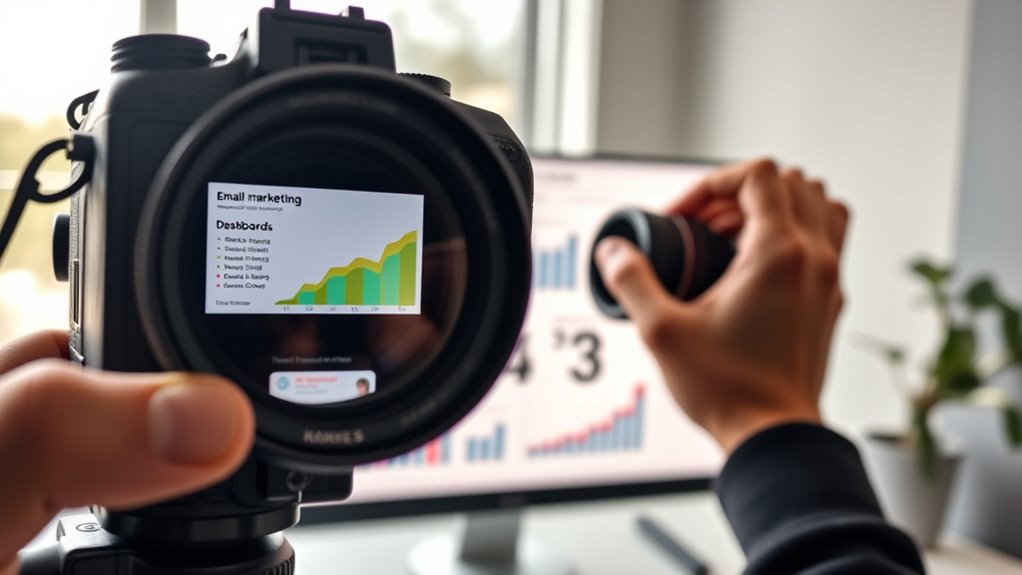To boost trial conversions, use engaging onboarding emails that highlight key features with visuals and personalized content, guiding users smoothly through your platform. For encouraging upgrades, tailor messages based on user behavior, preferences, and usage patterns while timing them strategically. To prevent churn, proactively reach out to at-risk customers with targeted, helpful emails and real-time updates. Keep your approach consistent across channels for a seamless experience—continue exploring how to refine these strategies for better results.
Key Takeaways
- Use personalized onboarding emails with visuals and tutorials to boost trial engagement and platform exploration.
- Segment users by behavior to send targeted upgrade offers that address specific needs and pain points.
- Implement behavioral triggers to send timely, relevant messages that nurture prospects and prevent churn.
- Maintain consistent cross-channel messaging to build trust, recognition, and a seamless customer journey.
- Analyze data to optimize send times, frequency, and personalization for higher engagement and retention.
Crafting Engaging Onboarding Emails to Maximize Trial Conversion

To maximize trial conversions, crafting engaging onboarding emails is essential. Your welcome email sets the tone, making a strong first impression that encourages users to explore your SaaS product. An effective onboarding sequence guides new users through key features and benefits, reducing confusion and frustration. Use clear, concise language and highlight how your platform solves their problems. Incorporate visuals or quick tutorials within your emails to enhance understanding. Keep the tone friendly and approachable, fostering trust from the start. A well-structured onboarding sequence ensures users feel supported and motivated to continue using your service, increasing the chances they’ll convert from trial to paying customer. Ultimately, engaging onboarding emails are a crucial tool to boost trial success and retention. Recognizing symbolism in users’ interactions can also help tailor your messaging to better meet their needs.
Personalization Strategies for Encouraging Upgrades

Personalization plays a key role in convincing users to upgrade from a free trial to a paid plan. By leveraging dynamic content, you can tailor your emails to highlight features that match each user’s usage patterns and needs. Customer segmentation allows you to group users based on their behavior, engagement level, or industry, enabling more relevant messaging. For instance, if a user frequently tests certain features, craft an email showcasing the benefits of upgrading to access advanced versions of those tools. Personalized content makes your messaging more compelling and relevant, increasing the likelihood of an upgrade. Focus on addressing individual pain points and demonstrating value, ensuring your emails resonate and prompt users to make the leap from trial to paid subscription. Additionally, understanding the contrast ratio of your projector can help you better visualize how to create optimal viewing environments that enhance the overall experience.
Timing and Frequency: Optimizing Email Cadence for Better Engagement

To improve your email engagement, you need to send messages at the right times when your audience is most receptive. Finding the balance in how often you email prevents your subscribers from feeling overwhelmed or ignored. Let’s explore how to identify ideal send times and maintain a cadence that keeps your audience engaged without overdoing it.
Ideal Send Times
Timing is crucial when it comes to email marketing, as sending messages at the right moments can greatly boost engagement. To improve your results, focus on timing optimization by identifying your audience’s ideal send time. This varies based on factors like industry, time zones, and customer behavior. Analyzing past open and click rates helps pinpoint when your subscribers are most receptive. Experiment with sending emails at different times and monitor performance to find patterns. Keep in mind, the goal is to reach your audience when they’re most likely to engage, not just when it’s convenient for you. By pinpointing the best send time, you increase your chances of higher open rates, better click-throughs, and stronger customer relationships. Regularly assessing your email cadence prevents clutter buildup and ensures your messaging remains relevant and effective.
Balancing Email Frequency
Finding the right moment to send your emails is just one part of effective engagement; equally important is determining how often to reach out. Sending too many emails can lead to email fatigue, causing recipients to ignore or unsubscribe. Conversely, too few messages may leave your audience disengaged or unaware of updates. Striking the right balance helps prevent inbox saturation, ensuring your messages stand out without overwhelming your subscribers. Monitor engagement metrics to identify ideal frequency; if open or click rates drop, consider reducing your email cadence. Personalize your approach based on user behavior, segmenting your list to tailor the volume of communication. Additionally, understanding audience preferences can help refine your email timing and frequency, making your campaigns more effective. Consistent, well-timed emails keep your audience engaged without risking fatigue or saturation.
Leveraging Behavioral Triggers to Nurture Prospects

Behavioral triggers are powerful tools in SaaS email marketing because they enable you to send highly relevant messages based on your prospects’ actions. By using behavioral segmentation, you can categorize users according to their interactions, preferences, and engagement levels. This allows you to tailor your messaging to meet their specific needs and interests. Trigger automation takes this a step further by automatically sending targeted emails when certain behaviors occur—such as signing up for a trial, abandoning a cart, or reaching a usage milestone. These timely, personalized messages nurture prospects effectively, keeping your SaaS offering top of mind and encouraging progression through the funnel. Leveraging behavioral triggers helps you build a more responsive, engaging communication strategy that fosters trust and increases conversions. Additionally, incorporating Tuning Techniques can optimize your email campaigns by aligning messaging with customer preferences and behaviors.
Tactics for Reducing Churn With Proactive Email Outreach

Building on the power of behavioral triggers, proactive email outreach becomes a vital strategy to reduce churn before customers decide to leave. By leveraging customer segmentation and churn analytics, you can identify at-risk users and craft targeted messages that address their specific needs. This approach helps you anticipate issues and engage customers before dissatisfaction grows. Imagine sending personalized check-ins, offering support resources, or sharing tailored feature updates. Visualize a dashboard highlighting customer segments most likely to churn, alongside automated emails addressing their pain points. Think about segmenting users by usage patterns, engagement levels, or account age. With these tactics, you’re not just reacting to churn — you’re preventing it through strategic, proactive communication that fosters loyalty and trust.
Analyzing Metrics to Refine Your Email Campaigns

To effectively refine your email campaigns, you need to analyze key metrics that reveal how recipients engage with your messages. Start with open rate analysis to identify which subject lines and send times resonate most. A/B testing is vital here—by testing different subject lines, content, or calls-to-action, you can determine what drives higher engagement. Pay attention to click-through rates as well, since they show how well your content compels recipients to act. Use these insights to optimize your campaigns continuously. Regularly reviewing these metrics helps you identify patterns and adjust your strategies for better results. Remember, data-driven decisions lead to more effective email marketing, increasing conversions, and reducing churn. Additionally, understanding recipient skin response to various content can help tailor your messaging for better engagement.
Integrating Email With Other Marketing Channels for Cohesive Customer Journeys

To create seamless customer journeys, you need to connect your email efforts with other marketing channels through effective messaging strategies. Ensuring a consistent brand experience across touchpoints helps build trust and recognition. Utilizing data integration techniques allows you to personalize messages and coordinate campaigns across platforms efficiently. Staying aware of supermarket hours today can also inform timing strategies for seasonal or promotional campaigns.
Cross-Channel Messaging Strategies
Integrating email with other marketing channels creates seamless customer experiences that boost engagement and conversion. To achieve this, focus on delivering personalized content across platforms while maintaining cross platform consistency. This approach guarantees your message feels unified, strengthening the customer journey. Visualize your efforts as a synchronized dance where every step complements the next:
- Coordinated social media campaigns reinforcing email offers
- Targeted retargeting ads aligned with email messaging
- Consistent branding across website, email, and app notifications
- Personalized content tailored to user behavior across channels
- Multi-channel loyalty programs rewarding ongoing engagement
Consistent Brand Experience
Achieving a consistent brand experience across all marketing channels guarantees your customers recognize and trust your business at every touchpoint. To do this, focus on brand consistency, ensuring your messaging, tone, and visual branding remain uniform across email, social media, website, and other platforms. Visual branding elements like logos, colors, and typography should be cohesive, reinforcing your brand identity. When your marketing channels align visually and contextually, customers experience a seamless journey that builds familiarity and loyalty. This consistency not only strengthens your brand image but also enhances customer confidence in your offerings. Remember, every interaction should reflect your brand’s core values and aesthetic, creating a cohesive experience that resonates and sticks in your audience’s mind. Additionally, maintaining content alignment across channels ensures your messaging remains relevant and trustworthy.
Data Integration Techniques
Creating a seamless customer experience requires connecting your email marketing efforts with other channels like social media, your website, and advertising platforms. Effective data integration techniques enable this by using API synchronization to automatically share information across systems. You’ll need to focus on data mapping to ensure customer details, behaviors, and preferences stay consistent. This allows for personalized, cohesive messaging at every touchpoint. Visualize a unified customer journey:
- Real-time updates syncing across platforms
- Customer profiles enriched with cross-channel insights
- Triggered campaigns based on combined data
- Consistent branding and messaging everywhere
- Automated workflows streamlining engagement
- Monitoring for content spoilage ensures your messaging remains relevant and trustworthy.
Frequently Asked Questions
How Can I Personalize Emails Without Overwhelming My Team?
You want to personalize emails without overloading your team, so start by leveraging dynamic content that automatically adapts to each recipient’s data. Use personalization automation tools to set up rules and triggers, streamlining the process. This way, you create tailored messages efficiently, freeing up your team’s time while still delivering relevant, engaging emails that resonate with your audience. Focus on automation to maximize impact with minimal effort.
What Are the Best Practices for Segmenting Trial Users?
Imagine opening a secret door—segmenting trial users is your key. Use behavioral triggers like feature usage, engagement levels, and sign-up sources to craft segmentation strategies. These help you target users with personalized messages, increasing conversion chances. Regularly update segments based on user activity, ensuring your outreach stays relevant. This approach turns trial users into loyal customers by delivering the right message at the right time.
How Do I Measure the Long-Term Impact of Email Campaigns?
To measure the long-term impact of email campaigns, focus on customer retention and revenue attribution. Track metrics like repeat purchases, subscription renewals, and engagement over time to see how campaigns influence loyalty. Use analytics tools to connect email interactions with customer lifetime value, helping you understand how your messaging drives sustained growth. Regularly review these insights to refine your strategies and maximize the long-term benefits of your email marketing efforts.
What Are Effective Strategies for Re-Engaging Inactive Users?
Re-engaging inactive users can feel like trying to revive a dead battery, but it’s doable. Use win back campaigns that offer personalized incentives or updates, and focus on *best* engagement timing to catch their attention. Send targeted emails at strategic moments, reminding users of your value. Consistent, personalized outreach sparks curiosity and encourages re-engagement, transforming dormant users into active ones before they slip away forever.
How Can I Integrate Email Data With CRM Systems Effectively?
To integrate email data with your CRM effectively, start by setting up API integration, which allows seamless data exchange. Focus on data synchronization to keep your contacts, engagement metrics, and campaign info up-to-date in real-time. Regularly review integration workflows to guarantee accuracy, and automate data updates whenever possible. This approach helps you gain an all-encompassing view of customer interactions, improving targeting and personalization across your marketing efforts.
Conclusion
By mastering these email strategies, you’ll turn prospects into loyal customers and keep churn at bay. Personalize, time your messages right, and use triggers to stay top of mind. Remember, success doesn’t happen overnight—patience is a virtue. Keep refining your campaigns based on the numbers, and don’t put all your eggs in one basket by integrating channels. With persistence, you’ll see your SaaS email marketing efforts pay off and reap the rewards.
Natali – Editor in Chief (Strategy and Mastery, AI Expert) Natali, our Editor in Chief, is the driving force behind our content’s strategic direction. With a keen eye for detail and a deep understanding of market trends, Natali ensures that our content is top-notch and strategically aligned with our client’s goals. Her expertise in AI helps to seamlessly integrate advanced technology into our marketing strategies, pushing the boundaries of conventional marketing.










